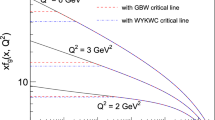Abstract
A nonlocal interaction theory is formulated for photoproduction processes by introducing a form function. An effective nonlocal, Lorentz invariant and gauge invariant Lagrangian density for the four-field interaction that gives rise to a production amplitude is constructed. The general structure of the form function is investigated by using some restrictions of the form function. For low energy π0 photoproduction an explicit form of the Fourier component of the form function is obtained. The physical model of the present formalism is to assume, similar to the strong absorption model, that the system in intermediate states is confined in a finite domain of space. For π0 production the linear dimension of this domain is obtained to beω 0 = 3·88F. It is important to observe that the extent of electromagnetic distribution in a nucleon is also nearly the size ofω 0. This is believed to be the reason that in low energy pion photoproduction the effects of electromagnetic structure of a nucleon are irrelevant. The unpolarized differential and total cross sections are calculated forπ 0 production in helicity representation and the predictions are found to be in good agreement with experiments.
Similar content being viewed by others
References
Akhiezer, A. I. and Berestetski, V. B. (1965).Quantum Electrodynamics (translated into English by G. M. Valkoff). Interscience Publishers, N. Y.
Berkelman, Karl and Waggoner, James A. (1960).Physical Review,117, 1364.
Bacci, C.et al. (1967).Physical Review,159, 1124.
Chew, G. F.et al. (1957).Physical Review,106, 1345.
Cambridge Bubble Chamber Group (1966).Physical Review,155, 1477.
Diebold, R. (1963).Physical Review,130, 2089.
DeWire, J. W.et al. (1958).Physical Review,110, 1208.
Donnachie, A. and Shaw, G. (1966).Annals of Physics,37, 33.
Drell, S. D. and Zachariasen, F. (1961).Electromagnetic Structure of Nucleons. Oxford University Press.
Eisenberg, Y.et al. (1966).Physical Review Letters 22, 217.
Frahn, W. E. and Venter, R. H. (1963).Annals of Physics,24, 243.
Gourdin, M. and Salin, Ph. (1963).Nuovo Cimento,27, 193.
Goldschmidt-Clermont, Y.et al. (1954).Physical Review,97, 188.
Highland, V. L. and DeWire, J. W. (1963).Physical Review,132, 1293.
Hofstadter, R. and Herman, R. (1961).Physical Review Letters,6, 592.
Jacob, M. and Wick, G. C. (1959).Annals of Physics,7, 404.
Jackson, J. D. and Hite, G. E. (1967).Physical Review,169, 1248.
Källen, G. (1964).Elementary Particle Physics. Addison-Wesley Publishing Company, Inc., p. 147.
McDonald, W. S.et al. (1957).Physical Review,107, 577.
Muirhead, H. (1965).The Physics of Elementary Particles. Pergamon Press, Oxford.
Oakley, D. C. and Walker, R. L. (1955).Physical Review,97, 1283.
Rédei, L. B. (1967).Physical Review,162, 1299.
Walker, R. L.et al. (1955).Physical Review,97, 1279.
Walker, R. L. (1963).Proceedings of the Conference on photon Int. in the Bev Energy Range, pp. iv, 6, MIT Report No. 2 (Bermard T., ed.).
Author information
Authors and Affiliations
Rights and permissions
About this article
Cite this article
Tang, L.H. Nonlocal theory of single pion photoproduction. Int J Theor Phys 5, 55–70 (1972). https://doi.org/10.1007/BF00671653
Received:
Issue Date:
DOI: https://doi.org/10.1007/BF00671653




